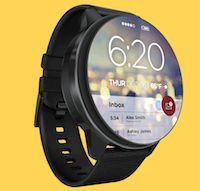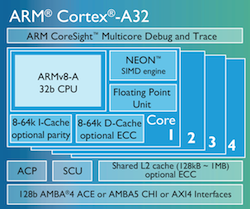 With the Mobile World Congress and Embedded World shows aligning this week, new processors have been popping up left and right. In this article, I’ll look at several that address the growing market for the Internet of Things (IoT), where modest power consumption and size are the winning tickets.
With the Mobile World Congress and Embedded World shows aligning this week, new processors have been popping up left and right. In this article, I’ll look at several that address the growing market for the Internet of Things (IoT), where modest power consumption and size are the winning tickets.
The biggest story for IoT was ARM’s announcement of its low-power Cortex-A32 processor, the first ARMv8 CPU designed specifically for 32-bit embedded devices. That includes wearables — a market targeted by Qualcomm earlier this month with its Android Wear-directed Snapdragon Wear 2100.
On the x86 side of the aisle, Intel unveiled the Atom x5-E8000, the heir to the Atom E3800 “Bay Trail” line and the first embedded-focused system-on-chip (SoC) based on the same 14nm Airmont architecture as the “Cherry Trail” and “Braswell” SoCs. In addition, AMD announced its third-generation embedded G-Series, which maintains modest 6-15 Watt TDPs while offering faster “Excavator” cores borrowed from its higher-end R-Series. It also adds pin compatibility with R-Series.
Here, I’ll focus on the IoT-targeted announcements, but there were also some chip announcements this week aimed primarily at Android-based mobile devices. These include the 14nm, octa-core Snapdragon 625 and 28nm Snapdragon 435 and 425, and the octa-core, Cortex-A53 Helio P20 SoC from MediaTek.
ARM Cortex-A32: IoT Game Changer
Only a few months after ARM unveiled the Cortex-A35 design — billed as its smallest, most power-efficient ARMv8 processor to date — the UK-based chip designer announced the ARMv8 Cortex-A32, which it claims is even smaller and more efficient. This is likely to be the chip of choice for several years of Linux-ready hacker SBCs, wearables, and other IoT gizmos.
The Cortex-A32 is the first ARMv8 chip that works only in 32-bit mode instead of also supporting 64-bit. Although it can’t match the maximum performance of the -A35, let alone the more powerful Cortex-A53 or -A72, it does keep with the -A35 in 32-bit mode.
The Cortex-A32 is 13 percent smaller than the Cortex-A35 and provides 10 percent higher “efficiency” — ARM’s term for performance per mW. The chip also provides 25 percent higher efficiency than the Cortex-A7, and 30 percent higher than the Cortex-A5, claims ARM.
The ARMv8-A architecture provides 100 new instructions missing from Cortex-A7 that improve efficiency in integer, floating point, and media operations. The Cortex-A32 is said to be especially adept at streaming and cryptography, where it provides 5.36 and 13.31 times the efficiency of the Cortex-A5, respectively.
The Cortex-A32 can be implemented in a stripped down, single-core version that runs on less than 4mW at 100MHz, all the way up to a more multimedia-friendly quad-core 1GHz config, where it runs at about 75mW. Operating system support includes all forms of Linux, as well as Android, Brillo, and Windows 10 IoT.
Snapdragon Wear 2100: New Life for Android Wear
The slow sales of watches based on Google’s Android Wear platform is due in part to the fact that most of the watches use an un-optimized, smartphone-oriented Snapdragon 400 SoC. Now, Qualcomm has unveiled a leaner Snapdragon Wear 2100 that specifically targets Android Wear and other wearables.
The quad-core, 800MHz to 1.2GHz Cortex-A7 SoC is 30 percent smaller and uses 25 percent less power than the Snapdragon 400, claims Qualcomm. The chip supports 640×480 pixels at 60fps resolution compared to typical Android Wear specs topping out at 400×400.
The Snapdragon Wear 2100 offers WiFi and Bluetooth 4.1/BLE, and there’s a version with either 3G or 4G LTE, enabling more autonomous operation. The chip also features an Adreno 304 GPU with OpenGL 3.0 and a DSP for modem, keyword, audio, and GNSS location processing. The DSP also fuels a sensor hub that is claimed to use 80 percent less power than the Snapdragon 400.
The Snapdragon Wear 2100 should give Android Wear wearables a fighting chance to compete with the Apple Watch while fending off lower-end fitness swatches. If that doesn’t work, expect to see watches in 2017 based on the Cortex-A32.
Intel Atom x5-E8000: Efficiency and Affordability at 14nm
Despite the fact that the Intel Atom has always done far better in embedded than in mobile, the embedded versions of the Atom often tip-toe in quietly without a formal announcement. The Atom x5-E8000 broke cover earlier this month when Congatec announced that three of its computer-on-modules and one Mini-ITX SBC would be retrofitted for the x86 SoC.
The Atom x5-E8000 is significant in that it’s the first truly embedded chip using Intel’s 14nm Airmont architecture, bringing major improvements compared to the 22nm Silvermont Atom E3800 family. While the Atom x5-E8000 name puts it in league with the similarly Airmont-based, mobile-oriented Atom x5 and x7 “Cherry Trail” processors, the design is more directly based on the Celeron N3000 of the Airmont-based, Celeron and Pentium branded Braswell line. Braswell chips, which are aimed at mini-PCs, 2-in-1s, and higher-end embedded systems, are faster than the Atom x5-E8000 but also much more expensive.
The quad-core Atom x5-E8000 has a lean 5W TDP, which is half the power consumption of the earlier quad-core Atom E3845. Just as importantly, it costs $39 compared to $52 for the E3845 and $107 for the quad-core Braswell based Celeron N3150. While Intel has been closing the gap with ARM processors on power consumption, this is the first major attempt to bring the processors in at a more ARM-like price as well.
Interestingly, the Atom x5-E8000 has a large gap between its low base clock rate of 1GHz to its high burst frequency of 2GHz. This likely reflects an intended role in IoT gateways, in which the device is typically running background tasks but must frequently step up for intensive communications and processing sessions.
The 320MHz graphics clock rate is lower than that of the Atom E3845, but like the other Airmont chips, as well as Intel’s Broadwell and Skylake Core CPUs, the Atom x5-E8000 has graduated to a much improved Intel Gen 8-LP GPU. In any case, we’ll likely see variations on the chip, some with more advanced graphics and others with no GPU at all.
Intel also announced two new Cherry Trail SoCs for mobile: the Atom x5-Z8350 and the USB 3.0-enhanced Atom x5-Z8330. Both offer higher burst modes of 1.92GHz compared to earlier x5 chips, as well as slightly lower power consumption.
AMD 3rd-Gen G-Series: Faster Cores and R-Series Compatibility
As the distant second behind Intel in the x86 market, AMD often gets overlooked in processor discussions. Yet, its G-Series SoCs have done fairly well in the embedded Linux market. The SoCs are supported with the Yocto Project-based Mentor Embedded Linux (MEL) distribution, a free Lite version of which is available for AMD’s new 3rd-Generation G-Series SoCs.
The new G-Series SoCs offer up to two of the faster “Excavator” x86 CPU cores that debuted last fall on the “Merlin Falcon” version of AMD’s higher-end R-Series family. These are the first G-Series chips to offer pin compatibility with R-Series, enabling easier migration.
The 3rd-Gen G-Series is divided into “Brown Falcon” (I) and “Prairie Falcon” (J) families. The 1.7GHz (2.0GHz burst) “Brown Falcon” is clocked lower than the 2.4GHz/2.8GHz “Prairie Falcon,” but it offers more powerful Radeon graphics. While “Brown Falcon” models range from 12-15W TDP, one “Prairie Falcon” model dips down to as low as 6W. This overall 6-15W range is similar to the previous “Steppe Eagle” generation, but the clock rates for CPU and GPU are considerably higher.
Congatec, which re-released its Conga-TR3 module with “Brown Falcon,” says the SoC offers up to 30 percent better graphics and 15 percent better system performance than the previous G-Series generation. Common features on both 3rd-Gen G-Series chips include support for DDR4 and 4K x 2K H.265 decode, as well as an AMD Secure Processor and 10-year longevity. Like all the processors listed in this article, the G-Series chips support Linux.


